- 1Indian Council of Agricultural Research (ICAR)-Indian Institute of Soil and Water Conservation, Dehradun, India
- 2Indian Council of Agricultural Research (ICAR)-Indian Institute of Soil and Water Conservation, Research Centre, Koraput, Odisha, India
- 3Agragamee, Rayagada, Odisha, India
- 4Odisha University of Agriculture and Technology, Bhubaneswar, Odisha, India
The Eastern Ghats of Odisha are ecologically fragile, facing land degradation, soil erosion, and livelihood insecurity. This study evaluates the carbon sequestration potential of 12 multipurpose tree species planted across slope gradients (upper, middle, and bottom) in 3 eco-villages of Rayagada district using a 1-acre family farm model. Results after 9 years revealed significant variations in the 1-acre farm model, with bottom slopes exhibiting the highest tree density (82 trees), average height (4.27 m), crown spread (4.5 m), and carbon sequestration (73.1 Mg CO2). Among species, A. occidentale and M. indica contributed the highest carbon stocks (7.27 and 6.97 Mg) and sequestration potential (26.70 and 25.59 Mg CO2, respectively), while S. glauca and C. siamea showed superior biomass (631.6 and 627.1 kg tree−1) after 9 years of plantation. The integrated 1-acre family farm model system produced carbon stock of 42.1 Mg acre−1, sequestered a total of 154.5 Mg CO2 acre−1, released 112.4 Mg oxygen acre−1, and generated carbon credits worth Indian Rupee (INR) 256437. Tree-based systems improved soil organic carbon and reduced bulk density and sustained crop yields and farm income (₹1.1–1.13 lakh per farmer) after 9 years of plantation. Overall, the findings demonstrate that slope-specific tree planting enhances ecological restoration, carbon sequestration, and livelihood resilience and provide a basis for eco-village–based agroforestry models to advance climate-smart development in the Eastern Ghats.
Introduction
The Eastern Ghats, a discontinuous mountain chain along the eastern coast of India, extend from West Bengal in the north to Tamil Nadu in the south, covering an area of nearly 75,000 km². The region harbors rich biodiversity, with tropical dry and moist deciduous forests, and supports vital ecosystem services, including carbon sequestration, water regulation, and provision of forest produce. The average annual rainfall in the region ranges between 1200 and 1500 mm. The Eastern Ghats are intersected by four major river systems—Mahanadi, Godavari, Krishna, and Kaveri—that drain into the Bay of Bengal. The area is also mineral-rich, with limestone, bauxite, and iron ore deposits, but unsustainable extraction has resulted in significant ecological degradation (Reddy et al., 2010; Das et al., 2023; Behera et al., 2024; The Hindu, 2023).
In southern Odisha, the Eastern Ghats are dominated by hilly rainfed uplands characterized by steep slopes, shallow soils, and high rainfall variability (Das et al., 2023). Traditionally, tribal communities practiced shifting cultivation supplemented with food gathering from forests, which sustained a diverse and nutritious food basket consisting of millets, upland paddy, pulses, oilseeds, and indigenous rice varieties (Ramakrishnan, 1992). However, commercial forest exploitation, mining, and soil erosion have led to a decline in soil fertility, reduced agricultural productivity, and loss of agrobiodiversity (Kumari, 2015; Jinger et al., 2024a, 2024b). Furthermore, climate variability—owing to erratic monsoons, delayed onset of rains, and intense rainfall events—has disrupted agriculture activities and resulted in increased crop failure rates (Mall et al., 2007). This large-scale degradation has exacerbated food insecurity and livelihood vulnerability among tribal households and has heightened the need for sustainable land-use solutions (Mohapatra, 2022; Das et al., 2023). Protecting this fragile ecosystem is crucial for checking land degradation and creating carbon for meeting the targets (2.5–3.0 billion Mg C) of the Paris Agreement (MoEFCC, 2015).
Eco-villages, integrating ecological restoration with livelihood security, have been proposed as a pathway for sustainable development in developing countries like India (Das et al., 2023; Kaushik, 2024). Agroforestry, a core component of eco-villages, when strategically integrated, has the potential to restore ecosystem functions and provide numerous ecosystem services, particularly in the hilly agro-ecosystem (Jose, 2009; Montagnini and Nair, 2004; Jinger et al., 2022). Trees in agroforestry capture atmospheric CO2 and store it in biomass and soils (Nair et al., 2009). Moreover, agroforestry also contributes to sustainable food and nutrition security, particularly in rainfed and degraded landscapes (Swamy and Puri, 2005; Jinger et al., 2023). Models such as the 1-acre family farm, which integrates trees, crops, and livestock to ensure food, nutrition, and livelihood security while enhancing carbon sequestration, are increasingly being adopted in rural areas, reflecting the practical potential of eco-village approaches (Das et al., 2023). The performance of trees and carbon stocks on degraded land is, however, dependent on site-specific conditions such as slope, aspect, and soil moisture. These variations underscore the importance of adopting slope-position–based planting strategies to optimize ecological restoration and livelihood outcomes (Yuan et al., 2019; Chen et al., 2021; Wang et al., 2025; Jinger et al., 2025). While agroforestry in India has been widely studied for its role in carbon sequestration, livelihood support, and slope-specific performance of tree species, it has received limited attention due to inadequate long-term and terrain-focused studies. This gap is particularly relevant in the Eastern Ghats, where undulating terrain strongly governs vegetation performance and ecological outcomes. There is an urgent need to synthesize data from local field experiments for more accurate and robust estimation of biomass and soil organic carbon (SOC) storage (Cardinael et al., 2018a). Understanding these variations can provide valuable guidance for designing site-specific agroforestry interventions, especially in the context of land degradation neutrality and climate change mitigation in Odisha (UNCCD, 2018).
The present study investigates how slope position influences growth, biomass production, and carbon sequestration of selected tree species within the 1-acre family farm model. We hypothesize that differences in soil moisture, nutrient availability, and microclimate across slopes lead to differences in growth, biomass, and carbon storage, with certain species performing better. The overall aim of the study is to generate evidence for designing 1-acre family farm models that support climate resilience, ecological restoration, biodiversity conservation, and livelihood resilience in the Eastern Ghats region.
Materials and methods
Study area
The study was conducted in three villages, Maligaon, Durukhal, and Dandabad, of the district Rayagada in the Eastern Ghats of Odisha. The District Rayagada is located between 19°20′35′′ and 19°22′38′′ N latitude and 83°0′0′′ E and 83°1′37′′ E longitude. The elevation of the site ranged between 716 and 1099 m amsl. These villages represent diverse topographical and environmental conditions, providing a suitable landscape to analyze the impact of slope position on tree growth, biomass accumulation, and carbon sequestration. The region experiences an average annual rainfall of 1521.5 mm with a tropical to subtropical climate with red and lateritic soil types. To assess the effect of slope position, three distinct slope categories having equal length along the slope were selected: upper slope characterized by steep gradients, lower soil moisture, and higher erosion risks; middle slope characterized by moderate soil moisture and nutrient availability; and bottom slope characterized by gently sloping land with higher soil moisture retention and organic matter accumulation. The pH of soil ranged from 5.7 to 6.2. Each 1-acre plot was converted to bench terraces for effective soil and moisture conservation.
Experimental design
A field-based experimental approach was employed on a farmer’s field to study the growth behavior, biomass production, and carbon sequestration performance of twelve tree species commonly found in Odisha. For this purpose, a 1-acre family farm model (1 acre = 4,000 m²/0.4 ha area) that integrates multipurpose trees and crops was designed and established on farmers’ fields in each of three selected villages during the year 2015. The tree species selected for the study include Acacia auriculiformis (Acacia), Emblica officinalis (Amla), Anacardium occidentale (Cashew), Cassia siamea (Chakunda), Annona squamosa (Custard apple), Bixa orellana (Jafra), Pongamia pinnata (Karanja), Mangifera indica (Mango), Moringa oleifera (Moringa), Azadirachta indica (Neem), Carica papaya (Papaya), and Simarouba glauca (Simarouba). Species were selected based on their local adaptability, economic significance, and ecological benefits as per expert consultation.
The slope of the experimental plots ranged from 0% to 90% and the steep slopes were converted to six terraces per farm for facilitating crop cultivation along with the multipurpose tree species. The study covered 15 1-acre family farm models distributed across three villages with five farmers in each village. Within each farm, three slope positions—upper, middle, and lower—were identified and planted with a fixed number of tree species (Tables 1, 2) to assess slope-wise variations in biomass and carbon accumulation. Each farm was considered a true replicate, as all farms were established under the same design and species composition but located on independent holdings with distinct slope gradients.
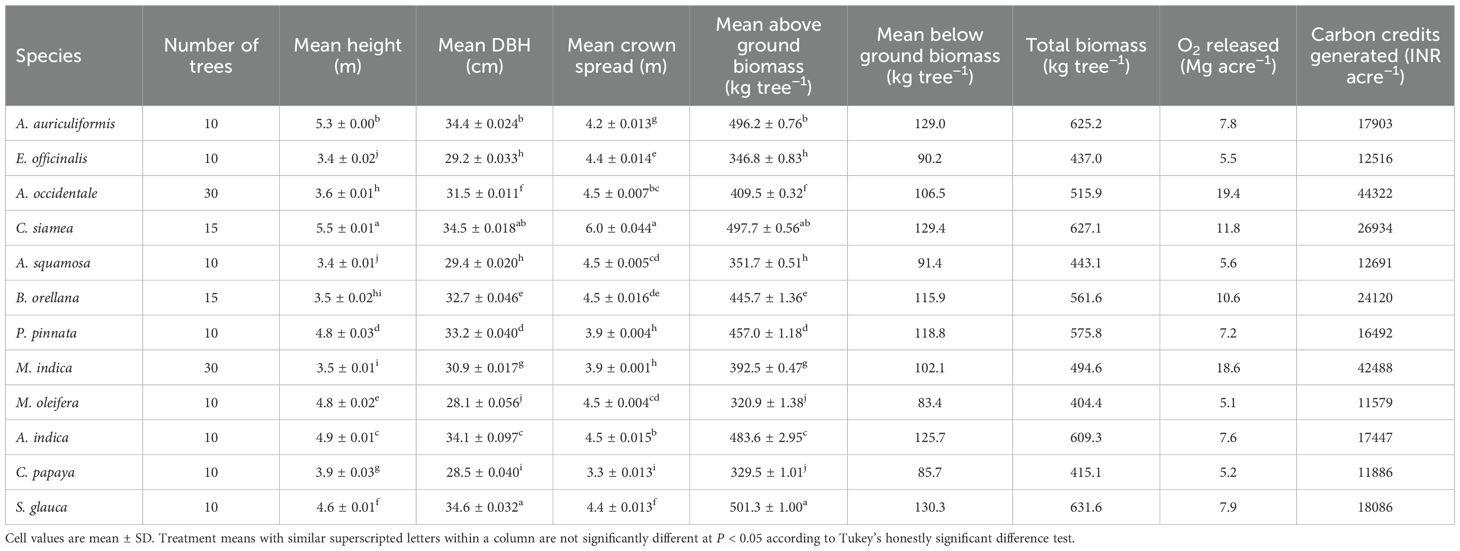
Table 1. Growth performance, oxygen released and carbon credits generated by the different tree species in 1-acre family farm model after 9 years of plantation.

Table 2. Growth performance of tree species by slope position from 1-acre family farm model after 9 years of plantation.
Randomization was achieved by randomly selecting farm plots within each village and assigning slope-based sampling positions within each plot. In total 170 trees belonging to 12 species were planted on each farmer’s field in a 1-acre area (4000m2). A. occidentale and M. indica were the most prevalent species planted, with an average of 30 trees per 1-acre family farm, followed by B. orellana and C. siamea with 15 trees each per family farm. The rest of the species have relatively lower counts, with 10 trees each per family farm. Management practices were standardized across farms to minimize confounding effects of individual farmer influence, ensuring experimental independence.
Growth and biomass
Growth performance indicators, including height, diameter at breast height (DBH), survival rate, and canopy spread, were measured after 9 years. Biomass was estimated using non-destructive sampling techniques (Hairiah et al., 2011) using the generalized biomass Equation 1 given by Nath et al. (2019):
Where, AGB = above ground biomass and D = diameter at breast height (cm)
The above equation was adopted since species-specific biomass equations were not available for several species in our dataset. Moreover, the equation has been developed and validated for a wide range of tropical tree species under environmental conditions comparable to our study area. Below-ground biomass carbon was estimated indirectly using a root-to-shoot ratio of 0.26 (IPCC (Intergovernmental Panel on Climate Change), 2006).
Carbon sequestration and carbon credit
The total carbon stock from vegetation was computed by multiplying the estimated biomass with 0.47 (Andreae and Merlet, 2001; IPCC (Intergovernmental Panel on Climate Change), 2006). The equivalent CO2 (CO2e) was estimated by multiplying total carbon storage values obtained from biomass with a factor of 3.67 (Pearson et al., 2007); biomass only and soil carbon sequestration were not included. The calculation of the oxygen (O2) release included multiplying the stored carbon by 2.67 as per the following formula (Equation 2):
The equivalent CO2 values of the stored biomass were used to determine the overall carbon credit for a given land use. Certified carbon credits were determined based on net CO2 from trees. These carbon credits, measured, were estimated by multiplying the net CO2 sequestration (Mg CO2-eq acre–1) by the value of C credits, where one C credit is equivalent to one Mg of CO2. The credit value was set at US$ 20, corresponding to INR 83 per US$ (1 US$ = INR 83). The carbon credit valuation of US$ 20 per Mg CO2e is based on 2024 voluntary market prices for carbon credits (QCIntel, 2024) and the carbon tax benchmark of Singapore in 2024 (Singapore Ministry of Finance, 2024) reported under Verified Carbon Standard (VCS) and Gold Standard projects (World Bank, 2023; ICVCM, 2024). However, carbon credit valuation is highly dynamic and depends on several factors, such as market demand, project certification, monitoring, verification, and permanence. Additional uncertainties arise from leakage risks, that is, displacement of emissions to non-project areas, and verification costs, which can range from 10% to 25% of gross carbon revenue. The sequestered carbon in biomass is also influenced by management and disturbance risks like fire, harvesting, outbreaks of insect pests, diseases, and so forth. Thus, the estimated value provides only an indicative economic potential, and actual returns would depend on successful registration under a recognized carbon standard and sustained ecosystem management.
Soil analysis
Soil samples were collected from the rhizosphere zone at 0–30 cm depths across slope positions in all villages. Samples were air-dried, ground, and passed through a 2-mm sieve for analysis. SOC and bulk density were determined according to Walkley and Black (1934) and Blake (1965), respectively. SOC stock was computed up to 30 cm soil depth (Cardinael et al., 2018b) using the following equation:
Yield and economics
Crop yields were recorded in five randomly selected farmers’ fields per village in all three villages for major crops—mango, vegetables, cashew, millets, paddy, and pulses grown under the 1-acre farm model during the year 2024. Yield was expressed on a per-farmer basis. Farm income was estimated by multiplying yield with local market prices. The average annual income per farmer was calculated separately for each village to compare economic performance across sites.
Statistical analysis
For statistical analysis, comparative assessments were conducted across species and slope positions to identify patterns and trends. The collected data were subjected to statistical analyses using R software. Analysis of variance was employed to determine whether significant differences existed in growth performance among species and across slope positions. Where significant differences were observed, post-hoc tests (Tukey’s HSD) were conducted to identify specific differences between groups (Gomez and Gomez, 1984).
Results and discussion
Growth performance
The analysis for different tree species revealed that height growth was highest in C. siamea (5.5 m), followed by A. auriculiformis with an average height of 5.3 m. E. officinalis and A. squamosa showed the lowest mean height (3.4 m). In terms of DBH, S. glauca had the highest DBH of 34.6 cm, followed by C. siamea (34.5 cm), A. auriculiformis (34.4 cm), and A. indica (34.1 cm). C. papaya showed the lowest DBH of 28.5 cm (Table 1). C. siamea has the largest crown spread at 6.0 m, suggesting that it requires more space and resources than other species, while other species like E. officinalis, A. occidentale, A. squamosa, B. orellana, A. indica and M. oleifera showed consistent spread of 4.5 m. (Table 1). The superior growth of C. siamea, A. auriculiformis, and A. indica may be due to their genetic traits or their adaptability and resource-use efficiency, which is consistent with earlier findings of Jaiswal and Singh (2015) and Swamy and Puri (2005), highlighting their fast growth under varied site conditions. In contrast, the poor performance of E. officinalis and A. squamosa suggests their sensitivity to competition. Korwar et al. (2006) also observed that E. officinalis can thrive under a variety of conditions but may struggle in heavily competitive environments. C. siamea largest crown spread indicates its competitive advantage for trapping light and photosynthesis and can result in more growth, which is also reflected in terms of good height growth of the species. Wang et al. (2025) also revealed significant differences in DBH among different forest types in China.
The analysis across different slope positions (upper, middle, and bottom) reveals significant variations (Table 2). The growth performance of tree species varied significantly across different slope positions. The bottom slope recorded the larger mean tree height (4.27 m) and largest crown spread (4.5 m). On the contrary, upper slopes recorded lower mean height (3.74 m) and crown spread (4.5 m). The DBH across slopes showed less variation, with values ranging from 31.4 cm (bottom) to 32.1 cm (middle). The greater number of taller trees on the bottom slope may be attributed to greater soil moisture retention and nutrient availability in the lower slope, which typically receives runoff from higher elevations (Liu et al., 2020; Chen et al., 2021). Previous studies have also reported that bottom slopes tend to accumulate nutrients washed down from higher slopes, which helps in promoting better plant growth (Yuan et al., 2019). This increase in soil moisture can prolong the growing season in trees (Al-Seekh and Mohammad, 2009). The least growth performance on the upper slope may be due to the harsher environment, as they often experience higher water runoff, leading to a shallow soil profile and less water available for plant growth. Additionally, greater wind exposure and higher temperatures at upper slopes increase evapotranspiration (Ebel, 2013; Wang et al., 2018).
The interaction effect of species × village and species × slope on growth performance (Table 3) revealed that C. siamea attained the maximum height and crown spread (5.9–6.1 m) across all villages and slope positions, highlighting its superior adaptability and growth potential under diverse site conditions. A. auriculiformis also exhibited better performance, particularly in Maligaon and at the bottom slope, with an average height of 5.26 m. Comparing slope positions, the average DBH across villages and slope positions (Table 4) was highest in S. glauca, followed closely by C. siamea, A. indica, and A. auriculiformis. In contrast, C. papaya and M. oleifera recorded the lowest DBH values, particularly on the bottom slope, reflecting their sensitivity to competition. The observed variations in height and DBH across slope positions may be attributed to differences in microclimate, soil depth, and moisture availability, as slope gradients directly affect vegetation performance by altering soil fertility and water dynamics (Chen et al., 2021). C. siamea showed larger crown spread at the bottom slope (Table 5), indicating favorable growth and better soil moisture retention on these slopes, which is also supported by Al-Seekh and Mohammed, 2009 and Liu et al. (2020). Furthermore, species with larger crown spread intercept rainfall and prevent soil erosion, and therefore, species like C. siamea, A. indica, A. occidentale, E. officinalis may be recommended for reducing soil erosion in bottom slopes. The results further align with the study of Li et al. (2025) and Wang et al. (2025), who revealed that elevation influences tree growth both directly and indirectly through its interactions with slope, crown competition index (CCI), and tree canopy height (CH).
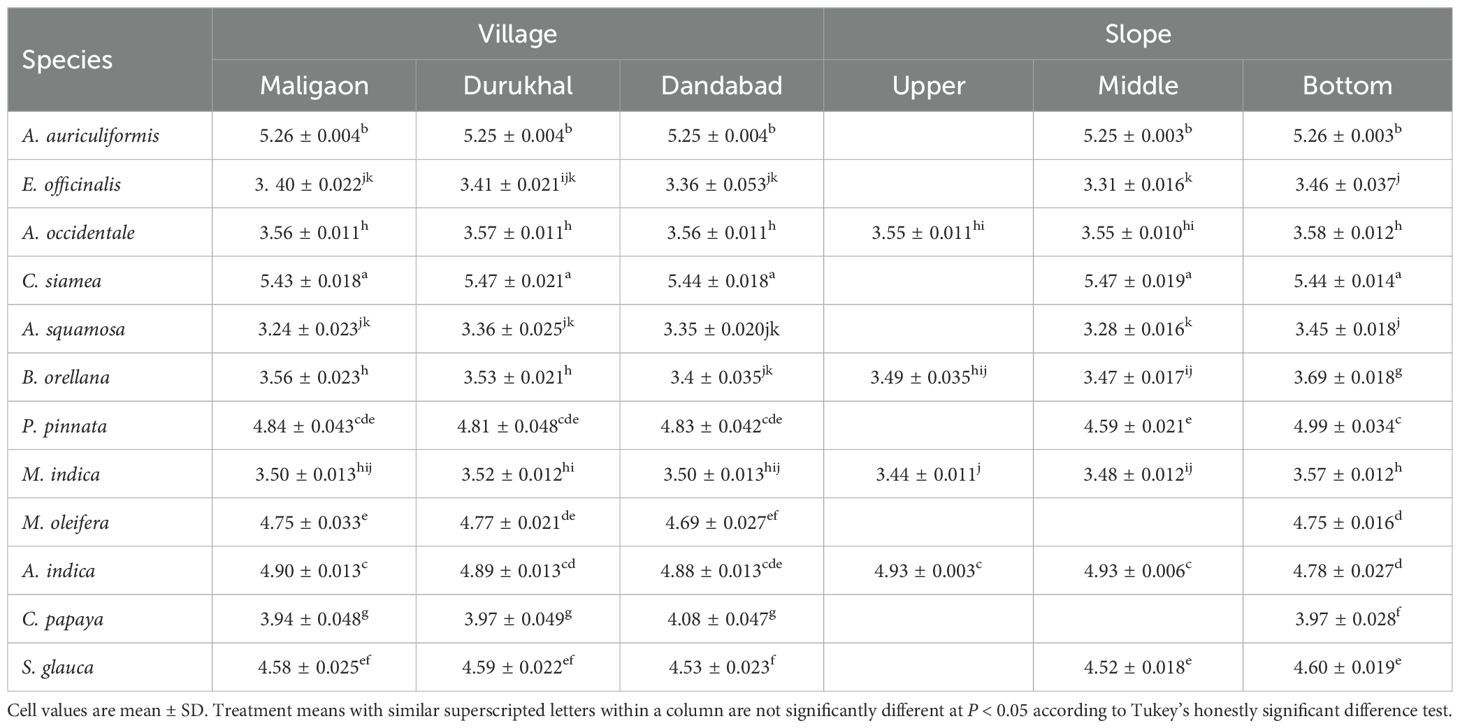
Table 3. Mean height (m) growth of different tree species across villages and slopes by the different tree species from 1-acre family farm model after 9 years of plantation.
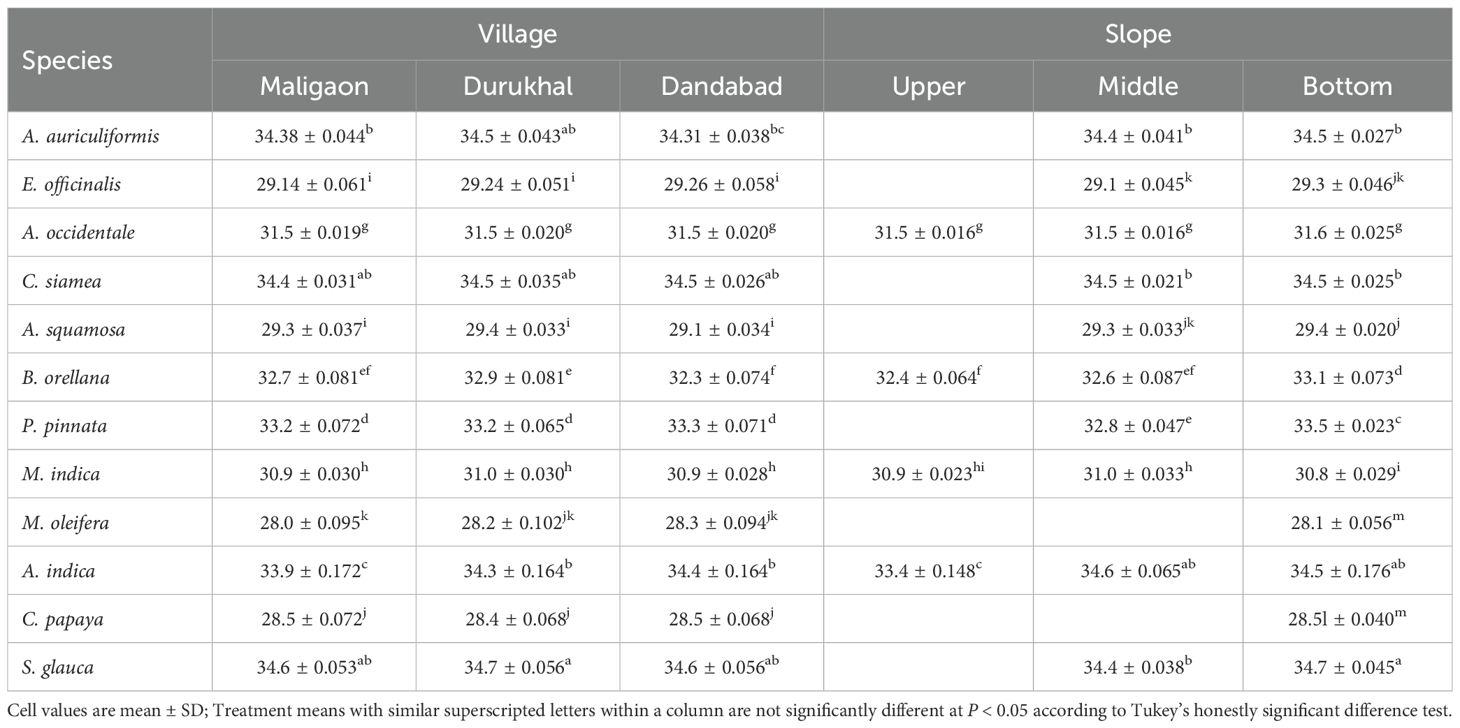
Table 4. Mean diameter (cm) at breast height (DBH) by different tree species across villages and slopes after 9 years of plantation.
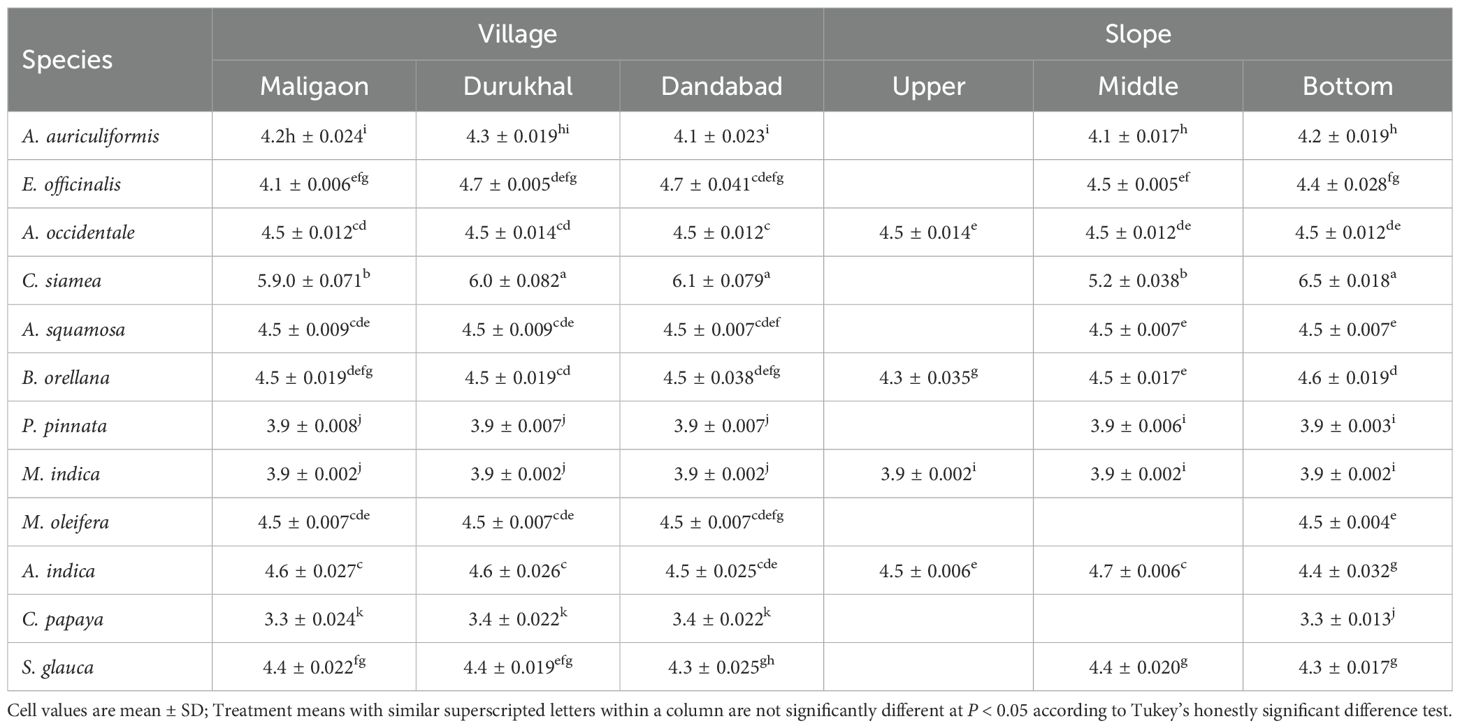
Table 5. Mean crown spread (m) by the different tree species across villages and slopes after 9 years of plantation.
Biomass, carbon stock, and CO2 sequestration
The analysis for different tree species after 9 years revealed the highest above ground biomass of 501.3 kg tree−1 was recorded in S. glauca, followed by C. siamea and A. auriculiformis, while M. oleifera had the lowest biomass of 320.9 kg tree−1 (Table 1). Below ground biomass also followed the similar trend. In M. indica, the biomass was 392.5 kg tree−1, which is lower than reported values from different Indian states (776.9 to 1574 kg tree−1, Ganeshamurthy et al., 2019). However, A. occidentale and M. indica recorded the highest total (above + below) ground carbon stocks (7.27 and 6.97 Mg, respectively), sequestering 26.70 and 25.59 Mg CO2, respectively, indicating their potential for carbon storage (Figure 1). M. oleifera and C. papaya recorded the lowest values of total (above + below ground) carbon stocks (1.90 and 1.95 Mg) and 6.98 and 7.16 Mg CO2. Overall, the results underscore the importance of selecting species with high carbon sequestration potential, such as A. occidentale and M. indica, which are widely grown by farmers. By promoting species with higher carbon sequestration potential and ensuring adequate planting densities, agroforestry practices can play a crucial role in mitigating climate change (Kanime et al., 2013). After 9 years, a total of 42.1 Mg of carbon stock was recorded with carbon sequestration of 154.5 Mg from a 1-acre area (family farm model, Figure 2). The higher carbon stocks in A. occidentale and M. indica can be attributed to the higher density of both species (30 trees). Furthermore, the variation in biomass among different species could be attributed to the genetic character, size and growth habit, growth rate, site quality, management practices, and its interaction with below ground crops (Oelbermann et al., 2004; Swamy and Puri, 2005; Kanime et al., 2013). The results further align with findings of Montagnini and Nair (2004) and Yohannes and Sewnet (2024).
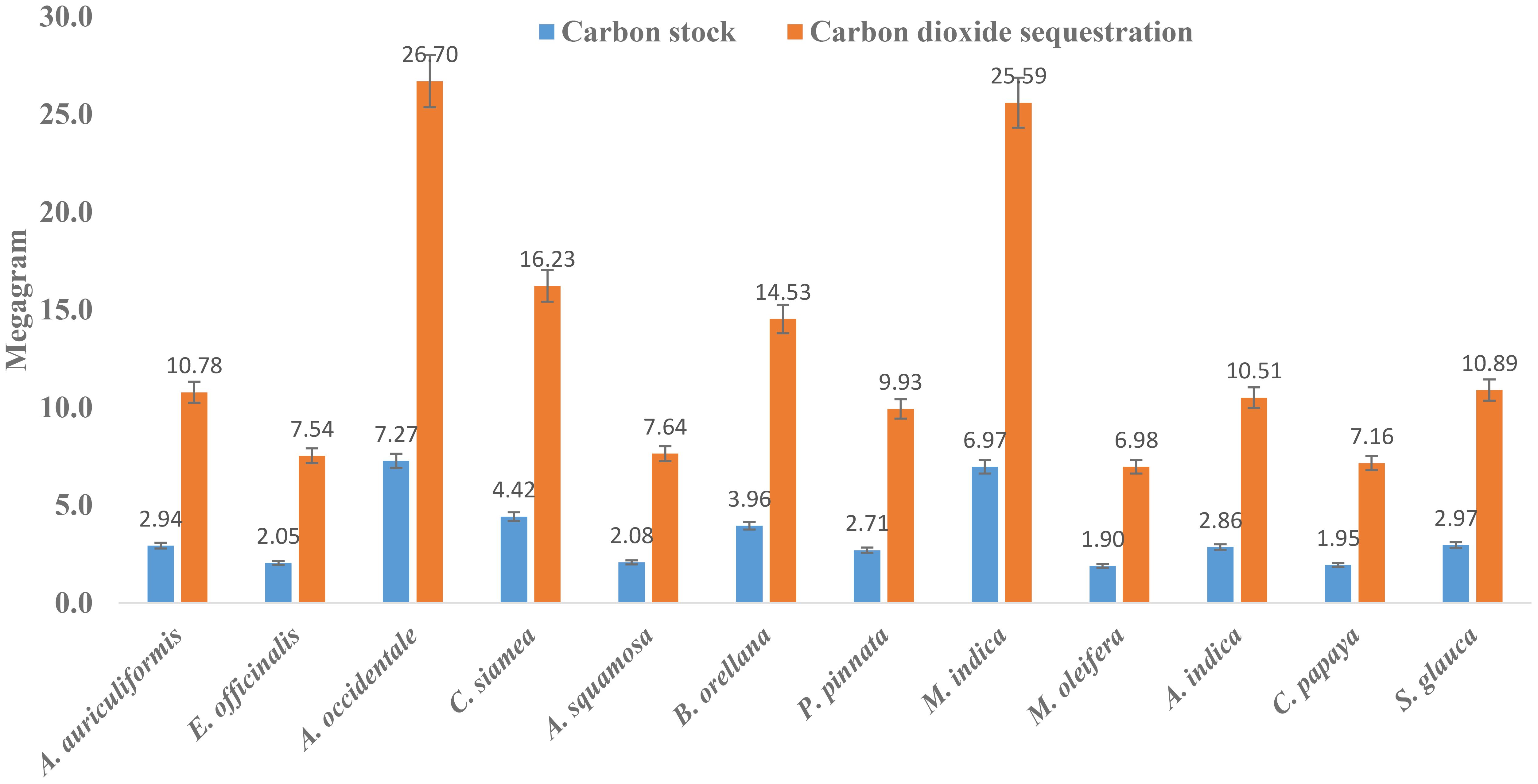
Figure 1. Species specific total (above + below ground) carbon stocks (CS) and total (above + below ground) CO2 sequestration (CDS) in 1-acre family farm model after 9 years of plantation. Error bars indicate LSD (P < 0.05).
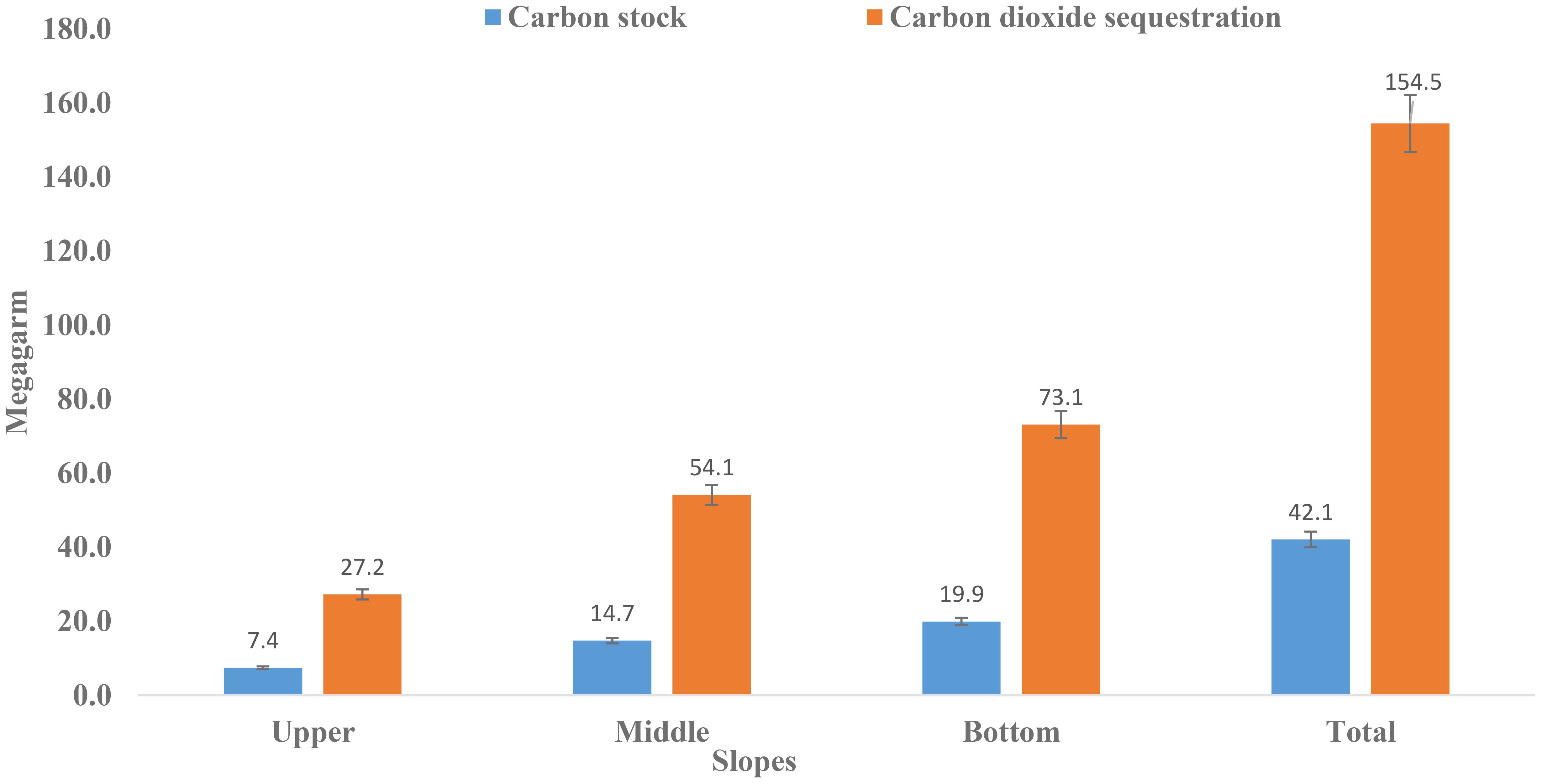
Figure 2. Distribution of Total (above + below ground) carbon stocks and total (above + below ground) CO2 sequestration by trees at different slopes in 1-acre family farm model after 9 years of plantation. Total represents the AGCS and AGCDS in Mg acre−1. sError bars indicate standard error of mean.
Comparing different slope positions after 9 years of plantation (Table 2), the highest total biomass per tree (541 kg) was observed at the middle slope, which was followed by the upper slope (526.6 kg). Trees at the bottom slope showed the lowest biomass (576.9 kg). Total carbon stock and carbon dioxide sequestration were highest (15.8 and 58.0 Mg, respectively) on the bottom slope. The upper slope had significantly lower values of total carbon and CO2 sequestration (7.4 and 27.2 Mg, respectively), which confirms that slope position is a critical driver of carbon storage, as lower slopes receive better soil moisture and organic matter (Clark and Clark, 2000; Laumonier et al., 2010; Huynh et al., 2023; Wang et al., 2025). Li et al. (2025) also underscores the importance of elevation in shaping the biomass carbon sink balance of mountain forests. The total carbon stock for the 1-acre farm model was 42.1 Mg acre−1, which sequestered 154.5 Mg CO2 acre−1 after 9 years of plantation (Figure 2). Despite of higher biomass at the middle slope, higher values of total carbon stock and carbon dioxide sequestration were recorded at the bottom slope. The difference in C stock between different slopes might be attributed to variations in planting density, which is in accordance with the findings of Montagnini and Nair (2004), who reported that the quantity of carbon sequestered varies by climate, soil, planting density, and system management. The values for carbon stock obtained in our study (42.1 Mg acre−1 equivalent to 105.25 Mg ha−1) are within the range (12–228 Mg C ha−1 with an average of 95 Mg C ha−1) reported by Albrecht and Kandji (2003) in different agroforestry systems. Further, our results are in accordance with the findings of Tadesse et al. (2008); Agbeshie and Abugre (2021); Santosh et al. (2025), and Wang et al. (2025), who also reported higher biomass and carbon stocks on lower slopes (Table 6). However, our results contradict the findings of Laumonier et al. (2010); Thapliyal et al. (2024), and Gauni et al. (2025).
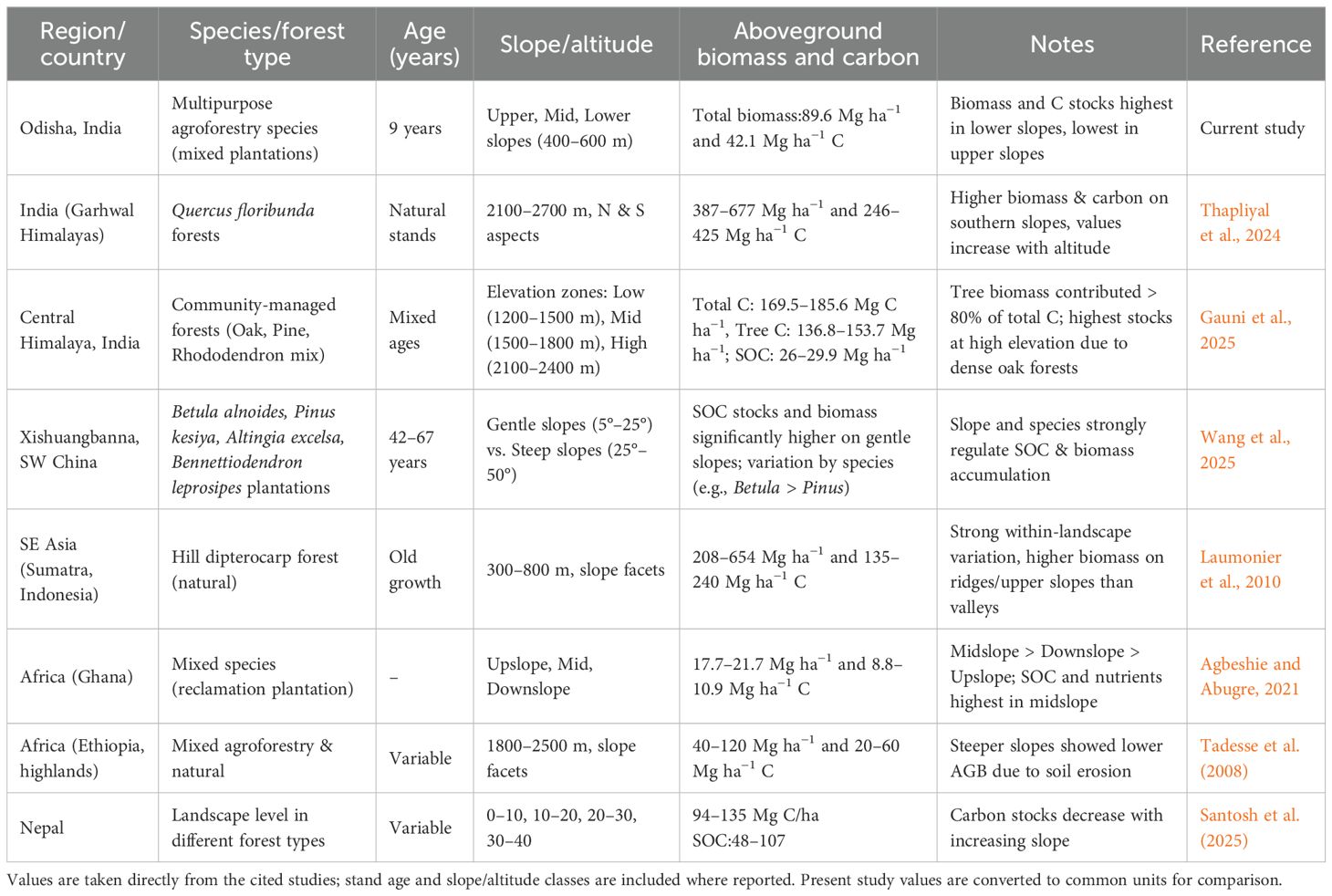
Table 6. Comparative summary of slope/topography effects on aboveground biomass (AGB) and carbon stocks across selected studies (India, China, SE Asia, Africa).
The analysis across different villages revealed that total aboveground carbon stock and carbon dioxide sequestration showed slight variation across the three study villages (Figure 3). The average aboveground carbon stock was 42.28 Mg acre−1 after 9 years of plantation in Durukhal, 42.02 Mg acre−1 in Maligaon, and 41.99 Mg acre−1 in Dandabad, while corresponding CO2 sequestration values were 155.16, 154.21, and 154.49 Mg acre−1, respectively. These values indicate a high degree of consistency across sites, suggesting that similar environmental and climatic conditions prevailing across the three villages, as well as comparable species composition and management practices. The uniformity observed in the present study is also consistent with reports that areas with similar soil and rainfall regimes tend to exhibit stable carbon accumulation across agroforestry systems (Kanime et al., 2013; Jinger et al., 2023). This consistency strengthens the case for scaling tree-based eco-village models in the Eastern Ghats, as carbon sequestration outcomes appear robust across different locations. It also suggests that slope position, rather than village-level factors, may be the more critical driver of carbon storage differences, as shown earlier in this study and supported by other slope–vegetation studies (Chen et al., 2021).
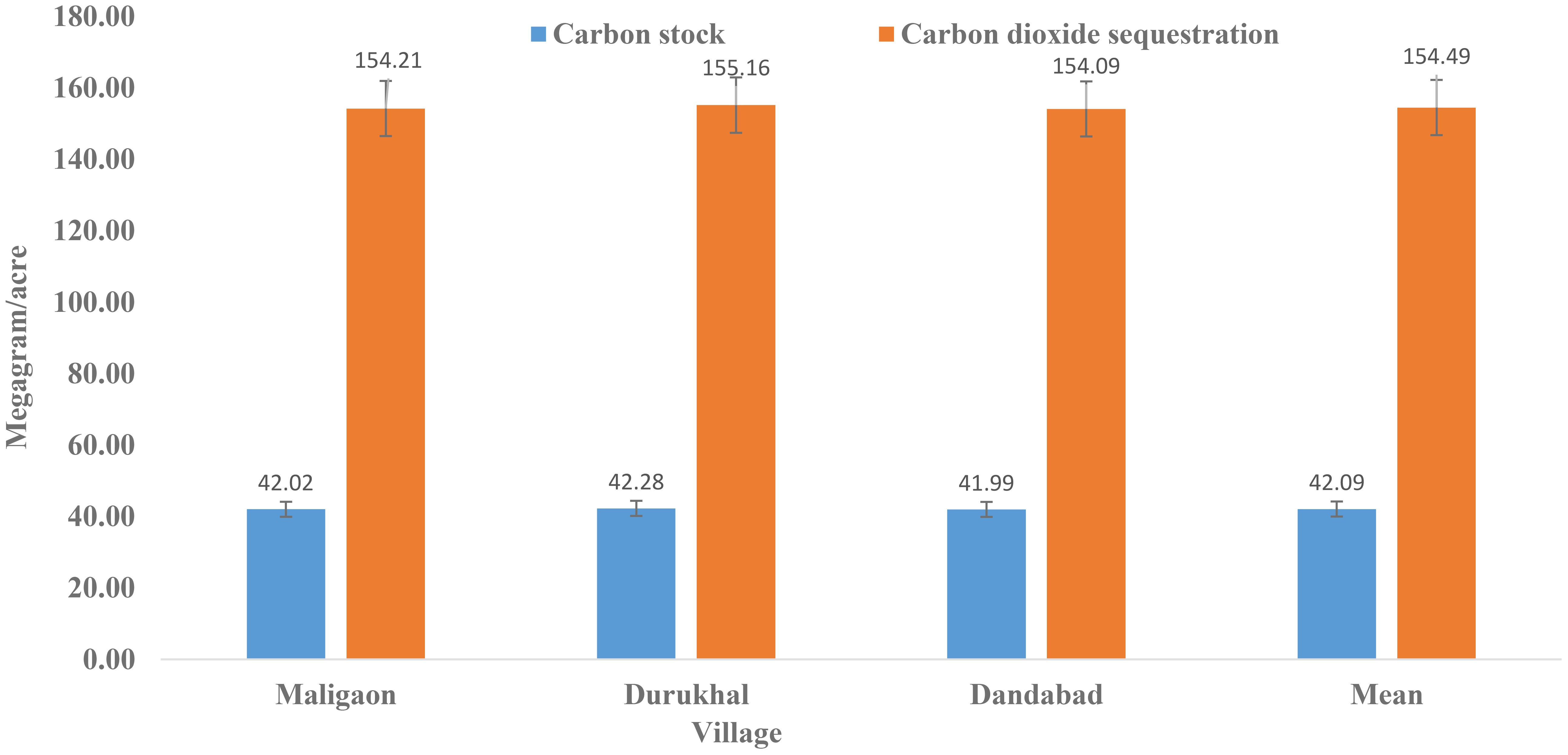
Figure 3. Total (above + below ground) carbon stocks and total (above + below ground) CO2 sequestration (AGCDS) by trees in three different villages from 1-acre family farm model after 9 years of plantation. Error bars indicates standard error of mean.
Interaction effects of species × village and species × slope after 9 years of plantation (Table 7) revealed that A. indica had a significantly higher total biomass in Durukhal (618.3 kg tree−1) compared to Dandabad (603.8 kg tree−1). Overall, the biomass performance on the upper slope was poor, and the majority of species performed best at the middle and lower slopes. S. glauca had the highest biomass, of 637.7 kg in the bottom slope, while, A. indica exhibited good performance in the middle slope (635.5 kg tree−1). The total (above + below ground) biomass carbon stock and CO2 sequestration data revealed distinct variations in species contributions across slope positions (Figure 4). However, not many variations were observed in different villages in term of biomass carbon stock and CO2 sequestration (Figure 5). A. occidentale (2.42–2.43 Mg C) and M. indica (2.31–2.34 Mg C) consistently recorded the highest aboveground carbon stocks across slopes, corresponding to CO2 sequestration values of 8.88–8.93 Mg and 8.48–8.58 Mg, respectively. Similar results were reported by Agboka et al. (2025) in cashew plantations in Togo across different climatic zones, indicating significant carbon storage potential. C. siamea showed notable slope-driven variation, with its carbon stock doubling from 1.47 Mg in the middle slope to 2.95 Mg in the bottom slope, resulting in a sequestration increase from 5.40 Mg to 10.83 Mg CO2. This trend supports earlier findings that species performance is closely tied to slope position, which governs microclimatic factors such as soil depth, runoff, and water retention (Chen et al., 2021; Muhammad et al., 2025). Species such as M. oleifera and C. papaya, although showing lower overall carbon stocks, displayed better performance on bottom slopes, highlighting their preference for moisture-rich conditions. Similar observations were made by Huynh et al. (2023), who reported higher biomass and carbon stocks on lower slopes in tropical plantations. These results underscore the importance of designing slope-sensitive, multi-layered agroforestry systems that combine high-density species (e.g., cashew, mango) with fast-growing and slope-adapted trees (e.g., C. siamea, A. indica). Such diversification can optimize both carbon sequestration and ecological services, including soil stabilization and nutrient cycling.
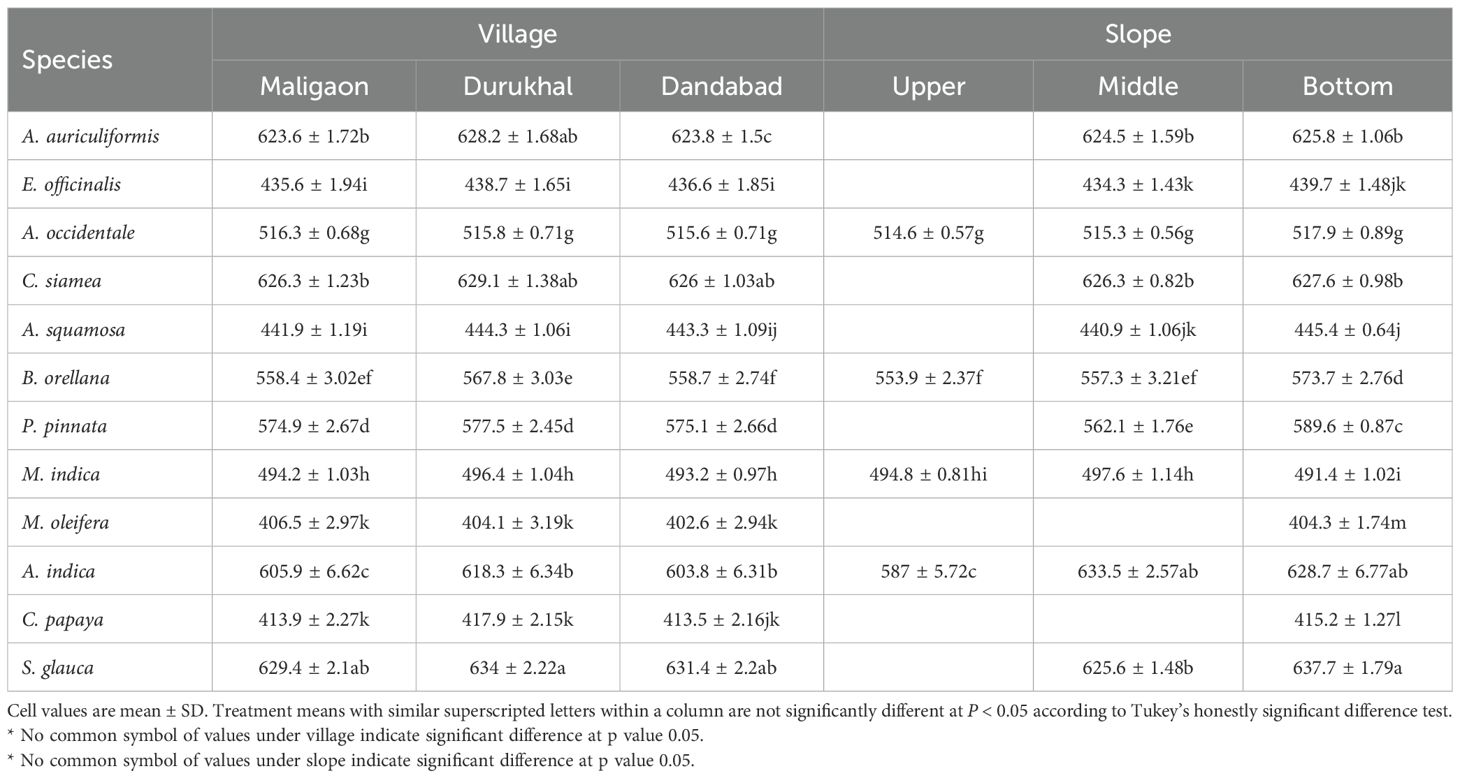
Table 7. Mean Total (above + below ground) biomass (kg tree−1) of different tree species across villages and slopes after 9 years of plantation.
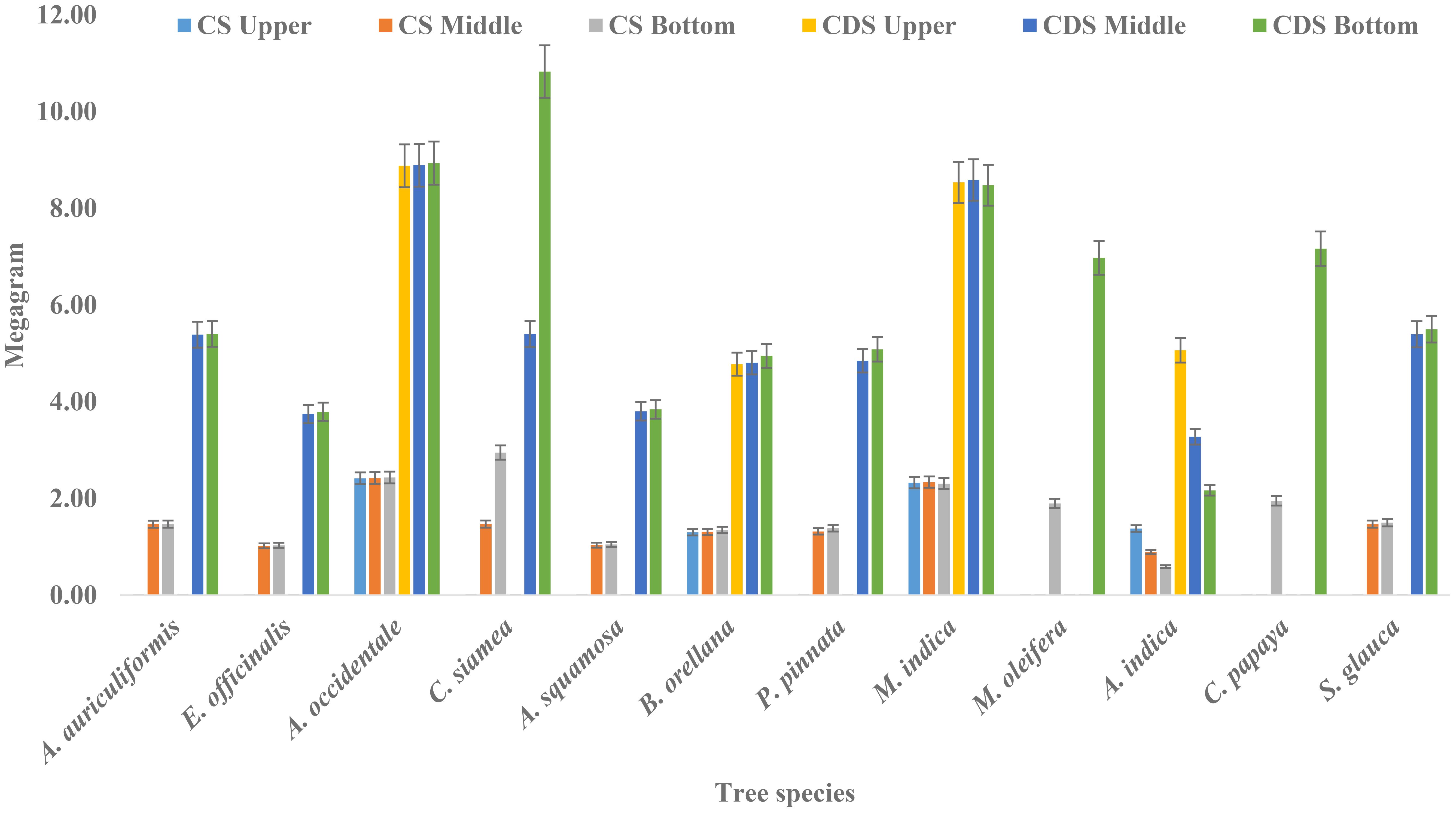
Figure 4. Species specific total (above +below ground) carbon stocks (CS) and total (above + below ground) CO2 sequestration (CDS) from trees at different slopes in 1-acre family farm model after 9 years of plantation. Error bars indicates standard error of mean.
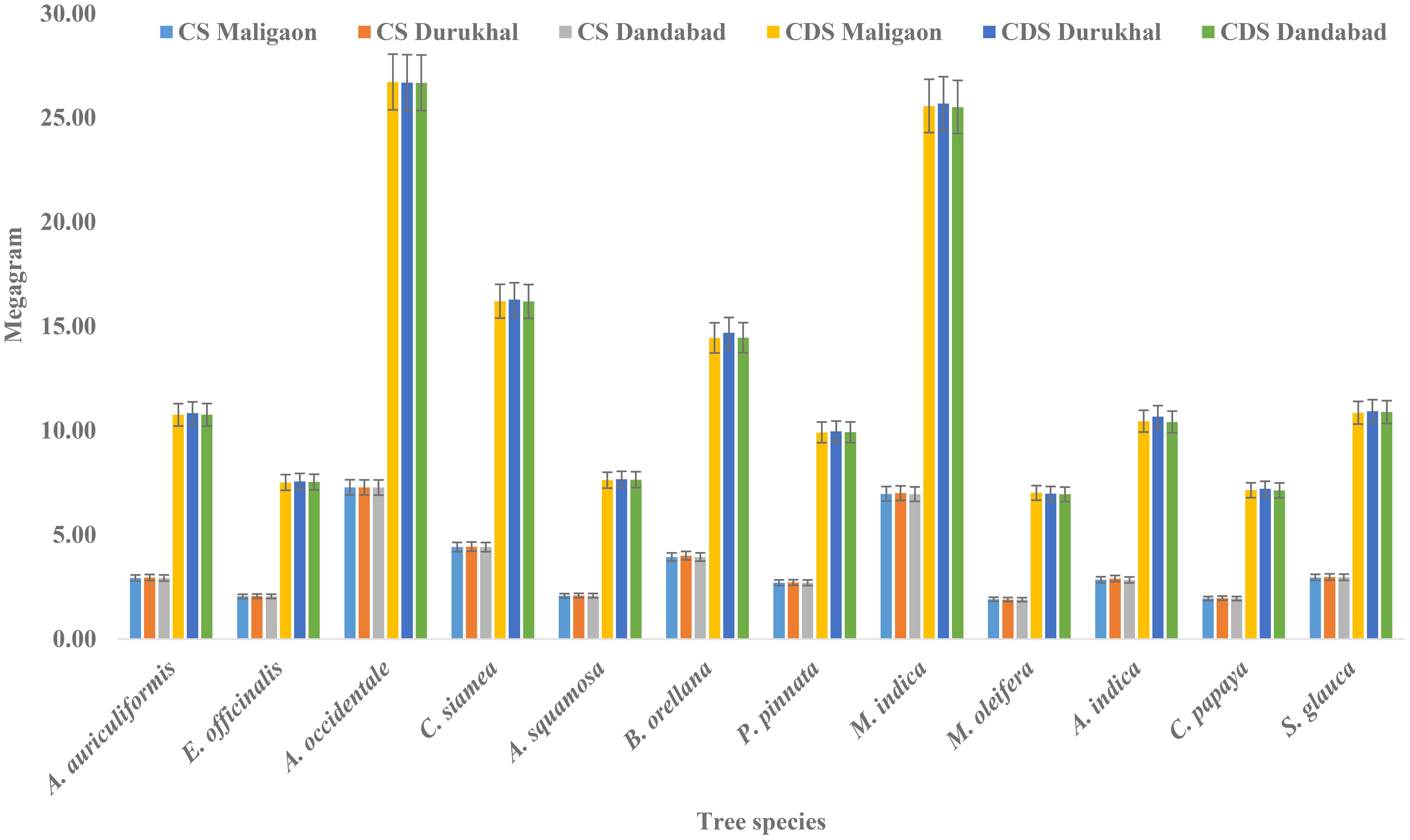
Figure 5. Species specific total (above + below ground) carbon stocks (AGCS) and total (above + below ground) CO2 sequestration in different tree species in three different villages from 1-acre family farm model after 9 years of plantation. Error bars indicate standard error of mean.
Oxygen released and carbon credit
All the species were assessed for their oxygen release capacity and the corresponding carbon credits generated (Table 1). Overall, 112.4 Mg of oxygen were released from the 1-acre farmer model, which generated carbon credits of INR 256464 acre−1. Comparing different species for oxygen release and carbon credit generation (Table 1), A. occidentale (19.4 Mg, INR 44322) and M. indica (18.6 Mg, INR 42488) were the top performers. C. papaya, M. oleifera, and E. officinalis exhibited lower values, contributing less than 6 Mg of oxygen. Highest values in A. occidentale and M. indica is due to their greater density and biomass accumulation, whereas C. papaya, M. oleifera, and E. officinalis showed comparatively lower contributions. These results reaffirm the importance of integrating high-density, multipurpose species for maximizing ecological and economic co-benefits in agroforestry systems (Montagnini and Nair, 2004). Overall, the 1-acre tree-based farming model released nearly 112.4 Mg of oxygen while generating carbon credits worth over INR 256437. A sensitivity analysis (± 25%) was conducted to account for price fluctuations commonly observed in voluntary markets. Accordingly, the potential range of carbon value of a 1-acre tree-based farming model for a period of 9 years lies between ₹192328 (–25%) and ₹320546 (+25%). This range reflects market variability and provides a more realistic estimate of possible financial outcomes under changing carbon price scenarios.
The analysis across different slope positions (upper, middle, and bottom) revealed variations in both oxygen release and carbon credit generation (Figure 6). The bottom slope contributed the highest share, releasing 53.2 Mg of oxygen and generating INR 121353 in carbon credits. This was followed by the middle slope with 39.4 Mg of oxygen and INR 89853 and the upper slope with 19.82 Mg and INR 45230, respectively. The cumulative output across all slopes was 112.4 Mg of oxygen and INR 256437 in carbon credits. These results suggest a positive relationship between slope position and oxygen release and carbon credit generation, with the bottom slope exhibiting the highest productivity and environmental benefits. Slope gradient was found to be a critical determinant of release of oxygen. The bottom slope, with better soil moisture retention and nutrient accumulation, recorded nearly three times higher oxygen release and carbon credits compared to the upper slope. Similar slope-driven variations in carbon sequestration have been reported in tropical and subtropical landscapes, where lower slope positions accumulate more biomass and carbon due to favourable micro-environmental conditions (Chen et al., 2021; Liu et al., 2020). This highlights the ecological advantage of prioritizing plantations in mid- and lower slope areas to optimize restoration outcomes.
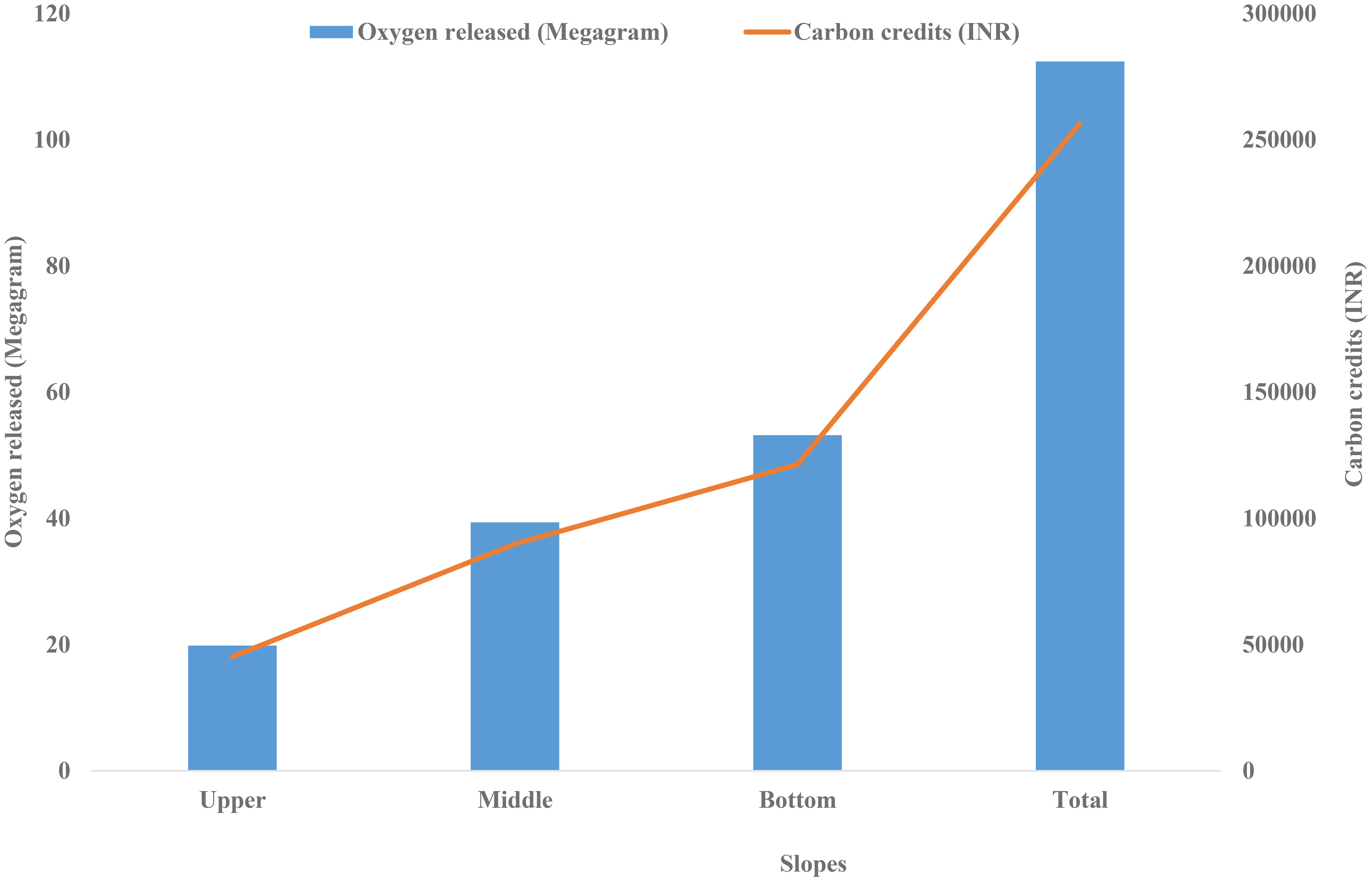
Figure 6. Slope-wise distribution of oxygen release and carbon credit generation in 1-acre family farm mode after 9 years of plantation. Total represents the oxygen release and carbon credit generation in Mg acre−1.
The village-wise comparison of oxygen release and carbon credit generation across Maligaon, Durukhal, and Dandabad villages (Figure 7) revealed consistent values. Durukhal village released the highest oxygen of 113.2 Mg and generated carbon credits worth INR 258481. Maligaon and Dandabad also showed similar results, with the release of 112.5 and 112.4 Mg of oxygen while generating carbon credits of INR 256646 and INR 256503, respectively. The overall average across the three sites was 112.7 Mg of oxygen. Interestingly, village-wise comparisons revealed minimal variation in oxygen release and carbon credits, suggesting that environmental conditions across the study sites were broadly similar. This consistency reinforces the robustness of the eco-village model, showing that slope position exerts greater influence than village-level differences in shaping ecosystem service outcomes, a trend also observed in earlier studies where topographic position was found to be a stronger determinant of biomass and carbon dynamics than site-level variations (Clark and Clark, 2000; Chen et al., 2021).
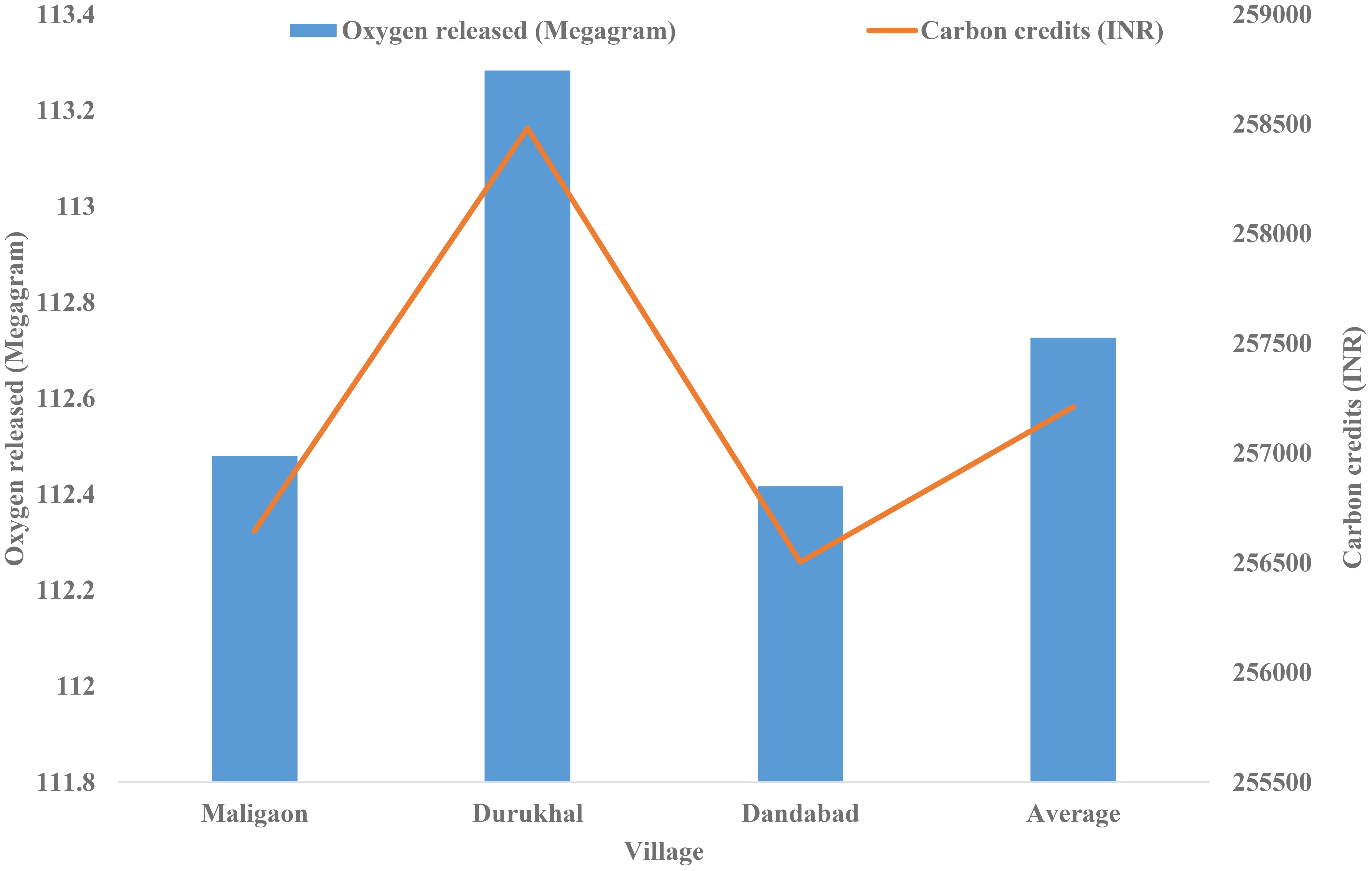
Figure 7. Village-wise comparison of oxygen release and carbon credit generation by in 1-acre family farm model after 9 years of plantation.
Soil fertility
The organic carbon content varied across different villages and slope positions (Table 8). Maligaon recorded the highest organic carbon content, with an average of 1.23%, followed by Dandabad (1.14%) and Durukhal (1.06%). Among the slopes, not much difference was observed among slopes planted with trees. However, in control plots, the lower slope exhibited higher organic carbon content compared to the middle and upper slopes. Slope locations impact spatial distribution of moisture, light, air, and tree stands and have an impact on soil physicochemical properties. (Nuchel et al., 2019). This higher organic carbon at a lower slope may be attributed to the interaction of hydrological and erosional processes along the slope gradient. Upper slopes often see more runoff and soil erosion, which remove fine particles and organic matter, resulting in lower biomass output due to reduced soil moisture and nutrient retention. Tree plantation, however, helped in enhancing SOC content in soil, which may be attributed to the addition of leaf litter and fine roots by the plantation. The interaction effect of village × slope revealed higher organic carbon (1.24%) in village Maligaon in the middle slope, suggesting that it may have better soil organic matter accumulation compared to the other villages. The least organic carbon (1.04%) was observed in Durukhal village in the middle slope, indicating the need for improved soil management practices to enhance carbon retention. Enrichment of SOC was observed in plots planted with trees as compared to control plots (without trees), indicating a positive effect of leaf litter on SOC. The differences in organic carbon content in various slopes and villages may be due to the addition of varying amounts of leaf litter, fine roots, and land topographic position resulting in differential moisture regimes and light conditions (Venkatesh et al., 2005; Kaushal et al., 2020). The bulk density (BD) values varied across different villages and slopes (Table 8). Soils in village Durukhal recorded the highest average bulk density at 1.31 Mg m−3, followed by Dandabad (1.29 Mg m−3) and Maligaon (1.27 Mg m−3). Across the three slopes, the bottom slopes showed the highest bulk density value of 1.32 Mg m−3, while the least was recorded in the middle slopes (1.26 Mg m−3). Zhao et al. (2025); Gauni et al. (2025), and Santosh et al. (2025) also reported differences in SOC stocks at different elevations. The interaction effect of village × slope revealed the highest values in the bottom slope in Maligaon village, while the least value was recorded in Maligaon village in the upper slope. The differences in bulk density between villages and slopes may be attributed to the initial differences of bulk density which can be seen from control plots. Overall, there was a slight reduction in bulk density, which may be attributed to the addition of organic matter through leaf litter, fine root production and turnover, and other related biological processes (Seobi et al., 2005; Udawatta et al., 2009). Decrease in BD and compaction under trees was also reported by Kaushal et al. (2016). The soil carbon stocks in 0–30 cm soil depth varied across the different villages and slope positions (Table 8). Maligaon exhibited the highest soil carbon stock, with an average of 18.7 Mg acre−1, followed by Dandabad (17.6 Mg acre−1) and Durkhal (16.7 Mg acre−1). The upper slopes showed the highest average (18.0 Mg acre−1) compared to the middle and bottom slopes. The fluctuations in soil carbon stock are determined by soil depth and climate gradient. Comparing villages and slopes, Maligaon showed the highest average soil carbon stock (19.9 Mg acre−1) at the bottom slope. In contrast, Dandabad had higher soil carbon stocks across the upper slope (19.1 Mg acre−1) and middle slope (17.2 Mg acre−1). This trend further suggests that the lower slopes in Maligaon may benefit from greater organic matter deposition and reduced erosion, contributing to higher soil carbon accumulation. Overall, the soil carbon reserves are higher than the IPCC’s (2003) estimate of 31 Mg C ha−1 for the dry tropics. This finding is consistent with previous research that emphasizes the accumulation of organic carbon in lower slopes due to sedimentation and reduced runoff. Muhammad et al. (2025) and Gao et al. (2025) also reported that elevation indirectly influences SOC stocks and forest regeneration in Kalam Temperate Forest in Pakistan.

Table 8. Organic carbon (%), bulk density (Mg m−3), and soil carbon stocks (Mg acre−1) in different villages at different slopes after 9 years of plantation.
Yield of different crops and total income
The average yield of M. indica was significantly higher (26.4 q farmer−1) in the farmers’ field of Durukhal village and was on par with Maligaon village farmers’ plot (26.2 q farmer−1). Significantly lower M. indica yield (24.4 q farmer−1) was recorded in the farmers’ fields of Dandabad village. However, there were no significant yield differences recorded for all other crops, such as vegetables (5.94–7.22 g farmer−1), A. occidentale (4.40–4.46 q farmer−1), millets (4.68–5.10 q farmer−1), paddy (16.60–19.40 q ha−1), and pulses (2.64–3.00 q farmer−1) in three villages. Therefore, the total farmers’ income (1.11–1.13 lakhs farmer−1) from all the crops were also non-significant in all three villages (Table 9). The yield analysis indicates that mango productivity varied significantly across villages, with Durukhal and Maligaon recording higher yields compared to Dandabad. This variation can be attributed to differences in soil fertility, slope position, and microclimatic factors, as fruit trees are highly responsive to site-specific resource availability (Nayak et al., 2020). Conversely, yields of vegetables, cashews, millets, paddy, and pulses showed no significant variation, suggesting that integration of trees in the eco-village model does not compromise staple crop performance. Similar observations have been reported in tree-based systems where crop productivity remained stable under well-managed agroforestry practices (Jose, 2009). Farm income across the three villages was statistically similar, despite differences in mango yield, highlighting the role of diversified production systems in stabilizing household earnings. This resilience stems from the combination of fruit, food grains, pulses, and vegetables, which together buffer farmers against risks of climate variability and market fluctuations (Jinger et al., 2023). The stable income pattern further emphasizes the potential of agroforestry-based eco-village models in enhancing livelihood security while contributing to ecological restoration in fragile landscapes such as the Eastern Ghats. These findings reinforce the argument that site-specific management of high-value perennials like mango, coupled with stable yields of food crops, can ensure both economic viability and food security.
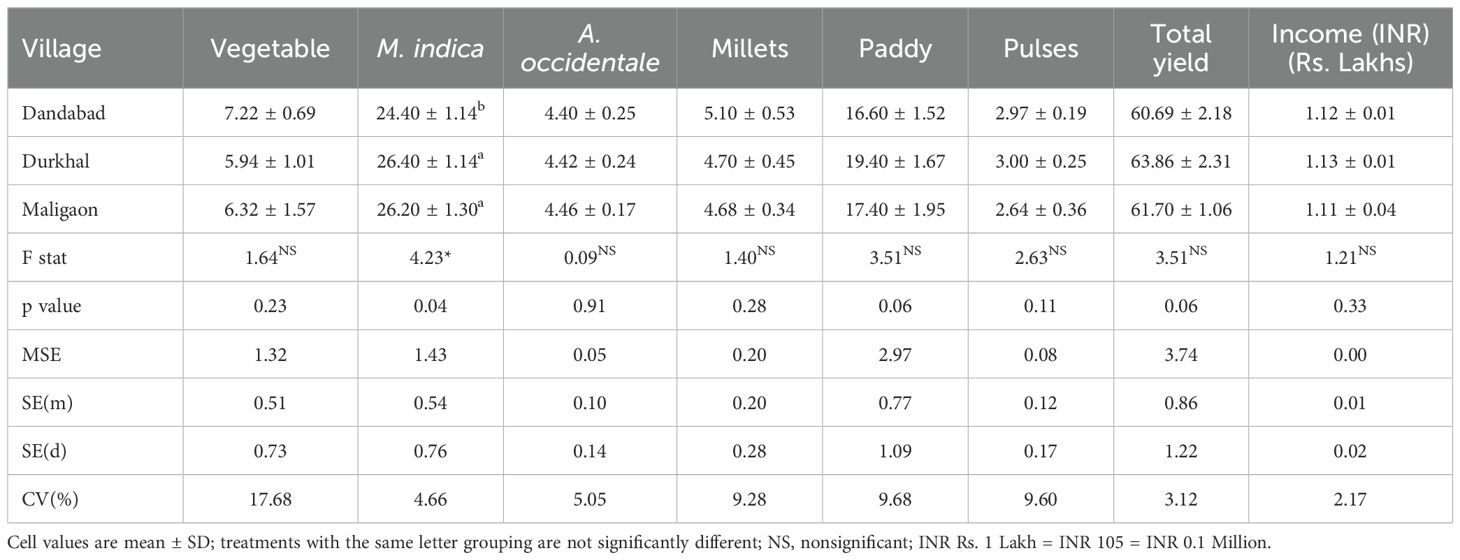
Table 9. Yield (q) of different crops and total income of farmers from three different eco-villages after 9 years of plantation.
Limitations and future perspectives
The results for above- and below-ground biomass are for a short monitoring period, and litter and deadwood carbon pools, which contribute to total ecosystem carbon, are not included in the study. Excluding these minor components may lead to a slight underestimation of total carbon stocks. Further, the study was limited to three villages, and results cannot be generalized across the Eastern Ghats. The future research needs to be focused on long-term monitoring of tree biomass and carbon dynamics (vegetation + soil) for a more comprehensive assessment of carbon sequestration potential. Soil health and socio-economic impact assessments also need to be included for further studies. There is also a need to upscale the 1-acre family farm model with policy support and carbon credit incentives.
Conclusions
This study underscores the significance of tree plantations in varying slope positions for sustainable development and restoration of degraded lands in the Eastern Ghats region of Odisha. The findings indicate that tree growth, biomass accumulation, yield, carbon sequestration potential, and total income vary across species and slope positions, emphasizing the need for site-specific afforestation strategies. A. occidentale and M. indica, demonstrated promising carbon sequestration abilities due to higher population, thereby making them viable candidates for large-scale plantation in addition to their economic returns. S. glauca, C. siamea, A. auriculiformis, and A. indica, due to higher biomass production (per tree), can be a potential species for enhancing carbon sequestration. The middle and bottom slopes generally exhibited higher biomass and carbon sequestration potential, suggesting their suitability for targeted reforestation efforts. Resilient species such as A. indica and B. orellana could be strategically planted on upper slopes where conditions are more challenging, while other moisture-loving species could be focused on mid and lower slopes. This targeted approach is likely to improve vegetation coverage, enhance root structure establishment, and reduce soil loss through both physical stabilization and organic matter accumulation. Conversely, species like M. oleifera, which exhibited lower growth metrics, may require more focused management practices to improve their health and productivity. Given Odisha’s vulnerability to erosion and its monsoonal climate, the findings of this study have practical implications for slope stabilization efforts in the region. Continued research and monitoring will be essential to adapt strategies that enhance the ecological and economic value of forested areas in the studied villages. By adopting sustainable vegetation-based solutions, policymakers and practitioners can work towards balancing conservation efforts with community-driven development initiatives in the region. Additionally, integrating these species into degraded landscapes could significantly contribute to regional and national climate change mitigation goals.
Data availability statement
The raw data supporting the conclusions of this article will be made available by the authors, without undue reservation.
Author contributions
PM: Conceptualization, Writing – review & editing. RK: Methodology, Formal analysis, Writing – original draft. SI: Formal analysis, Writing – review & editing. DR: Conceptualization, Writing – review & editing, Methodology. SK: Writing – review & editing, Conceptualization, Methodology. KJ: Data curation, Methodology, Writing – review & editing, Conceptualization. PL: Writing – review & editing, Conceptualization. JT: Methodology, Writing – review & editing, Conceptualization. MM: Supervision, Conceptualization, Writing – review & editing, Methodology.
Funding
The author(s) declare that no financial support was received for the research, and/or publication of this article.
Acknowledgments
The authors acknowledge the help and cooperation rendered by Shri Achyut Das, Director, NGO Agragamee and his Team in providing all the available primary and secondary information besides arranging for the field visits to interact with the farmers in the ecovillages to finalize this paper.
Conflict of interest
The authors declare that the research was conducted in the absence of any commercial or financial relationships that could be construed as a potential conflict of interest.
The handling editor VP declared a past co-authorship with the author(s) RK.
Generative AI statement
The author(s) declare that no Generative AI was used in the creation of this manuscript.
Any alternative text (alt text) provided alongside figures in this article has been generated by Frontiers with the support of artificial intelligence and reasonable efforts have been made to ensure accuracy, including review by the authors wherever possible. If you identify any issues, please contact us.
Publisher’s note
All claims expressed in this article are solely those of the authors and do not necessarily represent those of their affiliated organizations, or those of the publisher, the editors and the reviewers. Any product that may be evaluated in this article, or claim that may be made by its manufacturer, is not guaranteed or endorsed by the publisher.
References
Agbeshie A. A. and Abugre S. (2021). Soil properties and tree growth performance along a slope of a reclaimed land in the rain forest agroecological zone of Ghana. Sci. Afr. 13. doi: 10.1016/j.sciaf.2021.e00951
Agboka K., Tchamou N., and Dossou M. (2025). Carbon sequestration potential of cashew (Anacardium occidentale L.) plantations across climatic gradients in Togo. Int. J. Environ. Climate Change 15, 39–54. doi: 10.9734/ijecc/2025/v15i130276
Albrecht A. and Kandji S. T. (2003). Carbon sequestration in tropical agroforestry systems. Agric. Ecos. Env. 99, 15–27. doi: 10.1016/S0167-8809(03)00138-5
Al-Seekh S. H. and Mohammad A. G. (2009). The effect of water harvesting techniques on runoff, sedimentation, and soil properties. Environ. Manage. 44, 37–45. doi: 10.1007/s00267-009-9310-z
Andreae M. O. and Merlet P. (2001). Emission of trace gases and aerosols from biomass burning. Global Biogeochemical Cycles. 15, 955–966. doi: 10.1029/2000GB001382
Behera S., Pattanayak. K., and Bhadra A. (2024). The Eastern Ghat of India: A review on plant ecological perspectives. Plant Sci. Today 11, 441–449. doi: 10.14719/pst.3684
Cardinael R., Guenet B., Chevallier T., Dupraz C., Cozzi T., and Chenu C. (2018b). High organic inputs explain shallow and deep SOC storage in a long-term agroforestry system–combining experimental and modeling approaches. Biogeosciences 15, 297–317. doi: 10.5194/bg-2017-125
Cardinael R., Umulisa V., Toudert A., Olivier A., Bockel L., and Bernoux M. (2018a). Revisiting IPCC Tier 1 coefficients for soil organic and biomass carbon storage in agroforestry systems. Environ. Res. Lett. 13, 1–20. doi: 10.1088/1748-9326/aaeb5f
Chen C., Xin Z., Singh A. K., Xiai Z., Zhang W., Yang B., et al. (2021). Effects of hillslope position on soil water infiltration and preferential flow in tropical forest in southwest China. J. Environ. Management. 299, 113672. doi: 10.1016/j.jenvman.2021.113672
Clark D. B. and Clark D. A. (2000). Landscape-scale variation in forest structure and biomass in a tropical rain forest. For. Ecol. Manage 137, 185–198. doi: 10.1016/S0378-1127(99)00327-8
Das A., Mishra P. K., and Jena K. J. (2023). Eco-village development for the restoration of degraded hill slopes in the eastern ghats regions of Odisha- a concept in practice. Watershed Bulletin. 8, 1–8.
Ebel B. A. (2013). Simulated unsaturated flow processes after wildfire and interactions with slope aspect. Water Resour. Res. 49, 8090–8107. doi: 10.1002/2013WR014129
Ganeshamurthy A. N., Ravindra V., and Rupa T. R. (2019). Carbon sequestration potential of mango orchards in India. Curr. Science. 117, (12):2006.
Gao C., Li Z., Chai Y., Li J., and Cui K. (2025). Slope position affects growth and allometry of Calocedrus macrolepis by mediating soil properties and microbial communities. J. Plant Ecology. 18, rtaf054. doi: 10.1093/jpe/rtaf054
Gauni N., Ram J., and Lodhiyal L. S. (2025). Carbon dynamics in community-managed forests cross a altitudinal gradient in central Himalaya, India. Indian J. Ecol. 52, 701–707.
Gomez K. A. and Gomez C. M. (1984). Statistical Procedures for Agricultural Research (New York: John Wiley Sons Ine).
Hairiah K., Dewi S., Agus F., Velarde S., Ekadinata A., Rahayu S., et al. (2011). Measuring Carbon Stocks Across Land Use Systems: A Manual (Bogor, Indonesia: World Agroforestry Centre (ICRAF), SEA Regional Office), 154.
Huynh T., David J. L., Tom L., and Grahame A. (2023). Effects of site characteristics and stand management on biomass and carbon sequestration in spotted gum (Corymbia citriodora subsp. variegata) plantations. For. Ecol. Management. 529, 120725. doi: 10.1016/j.foreco.2022.120725
ICVCM (2024). Core Carbon Principles and Assessment Framework (Integrity Council for the Voluntary Carbon Market (ICVCM). Available online at: https://icvcm.org/core-carbon-principles/ (Accessed August 20, 2024).
IPCC (Intergovernmental Panel on Climate Change) (2003). Good Practice Guidance for Land Use, Land-Use Change and Forestry (GPG-LULUCF). Penman J., Gytarsky M., Hiraishi T., Krug T., Kruger D., Buendia L., Miwa K., Ngara T., Tanabe K., and Wagner F. (eds.). (Hayama, Japan: Institute for Global Environmental Strategies (IGES)).
IPCC (Intergovernmental Panel on Climate Change) (2006). Guidelines for National Greenhouse Gas Inventories, Volume 4: Agriculture, Forestry, and Other Land Use (Hayama, Kanagawa, Japan: Institute for Global Environmental Strategies (IGES)).
Jaiswal A. K. and Singh J. P. (2015). How to culture lac insect on Schleichera oleosa (kusum) tree? (Namkum, Ranchi, Jharkhand, India: Indian Institute of Natural Resins and Gums), 1–18.
Jinger D., Kakade V., Bhatnagar P. R., Paramesh V., Dinesh D., Singh G., et al. (2024b). Enhancing productivity and sustainability of ravine lands through horti-silviculture and soil moisture conservation: A pathway to land degradation neutrality. J. Environ. Management. 364, 121425. doi: 10.1016/j.jenvman.2024.121425
Jinger D., Kakade V., Kaushal R., Bhatnagar P. R., Ghosh A., Mahawer S. K., et al. (2025). Nature-based solutions for enhancing soil health and CO2 sequestration in degraded ravine lands through silvo-aromatic system and soil moisture conservation techniques. J. Environ. Management. 380, 124904. doi: 10.1016/j.jenvman.2025.124904
Jinger D., Kaushal R., Kumar R., Paramesh V., Verma A., Shukla M., et al. (2023). Degraded land rehabilitation through agroforestry in India: Achievements, current understanding, and future prospectives. Front. Ecol. Evol. 11. doi: 10.3389/fevo.2023.1088796
Jinger D., Kaushal R., Nandha Kumar N., Kala S., Sirohi C., Mandal B. S., et al. (2024a). “Amenable agroforestry approaches for restoration of mine spoil areas,” in Ecological Impacts of Stone Mining. Eds. Sharma G. K., Rashmi I., Ali S., Kala S., Kumar A., and Madhu M. (Springer, Singapore). doi: 10.1007/978-981-97-4746-7_13
Jinger D., Kumar R., Kakade V., Dinesh D., Singh G., Pande V. C., et al. (2022). Agroforestry system for controlling soil erosion and enhancing system productivity in ravine lands of Western India under climate change scenarios. Environ. Monit. Assessment. 194, 267. doi: 10.1007/s10661-022-09910-z
Jose S. (2009). Agroforestry for ecosystem services and environmental benefits. Agroforestry Systems. 76, 1–10. doi: 10.1007/s10457-009-9229-7
Kanime N., Kaushal R., Tewari S. K., Raverkar K. P., Chaturvedi S., and Chaturvedi O. P. (2013). Biomass production and carbon sequestration in different tree-based systems of Central Himalayan Tarai region. Forests. Trees Livelihoods 22, 38–50. doi: 10.1080/14728028.2013.764073
Kaushal R., Singh I., Thapliyal S. D., Gupta A. K., Mandal D., Tomar J. M. S., et al. (2020). Rooting behaviour and soil properties in different bamboo species of Western Himalayan Foothills, India. Sci. Rep. 10, 4966. doi: 10.1038/s41598-020-61418-z
Kaushal R., Verma A., Mehta H., Mandal D., Tomar J. M. S., Jana C., et al. (2016). Soil quality under Grewiaoptiva based agroforestry systems in western sub-Himalaya. Range Mgmt. Agroforestry. 37, 50–55.
Kaushik H. (2024). Advocating ‘eco-village’ for sustainable development. The dayalbagh way of life. Eco Cities. 5, 2773. doi: 10.54517/ec.v5i1.2773
Korwar R., Pratibha G., Ravi V., and Palanikumar V. D. (2006). Influenee of organics and inorganics on growth, yield of aonla (Emblica offizcinalis) and soil quality in semi-arid tropics. Indian J. Agric. Sci. 76, 457–461.
Kumari R. V. (2015). Protection of Eastern Ghats from land degradation. World J. Pharm. Res. 4, 2036–2040.
Laumonier Y., Edin A., Kanninen M., and Munandar A. W. (2010). Landscape-scale variation in the structure and biomass of the hill dipterocarp forest of Sumatra. Implications carbon stock assessments. For. Ecol. Manage. 259, 505–513. doi: 10.1016/j.foreco.2009.11.007
Li Z., Lin W., Guan Z., Zhang J., Chen S., and You W. (2025). Tree growth and mortality of secondary evergreen broadleaved and temperate coniferous forests and their drivers along elevation gradients in subtropical mountain of China. J. Forestry Res. 36, 1–12.
Liu R., Pan Y., Bao H., Liang S., Jiang Y., Tu H., et al. (2020). Variations in soil physico-chemical properties along slope position gradient in secondary vegetation of the hilly region, Guilin, Southwest China. Sustainability. 12, 1303. doi: 10.3390/su12041303
Mall R. K., Singh R., Gupta A., Srinivasan G., and Rathore L. S. (2007). Impact of climate change on Indian agriculture: a review. Climatic Change. 82, 225–231. doi: 10.1007/s10584-006-9236-x
MoEFCC (2015). India’s Intended Nationally Determined Contribution (Ministry of Environment, Forest and Climate Change, Government of India). Available online at: https://moef.gov.in/uploads/2018/04/revised-PPT-Press-Conference-INDC-v5.pdf (Accessed December 25, 2015).
Mohapatra S. P. (2022). “Degradation of Tribal Forest-Ecosystem and Food insecurity among Kutia Kondh tribe of Odisha-A Major Concern in 21st Century,” in XV World Forestry Congress, Seoul, Republic of Korea (Rome, Italy: FAO).
Montagnini F. and Nair P. K. R. (2004). Carbon sequestration in tropical agroforestry systems. Climatic Change. 63, 237–255.
Muhammad B., Hayat U., Gopakumar L., Xiong S., Ali J., Badshah M. T., et al. (2025). Altitudinal variations in coniferous vegetation and soil carbon storage in Kalam temperate forest, Pakistan. Plants. 14, 1534. doi: 10.3390/plants14101534
Nair P. K. R., Kumar B. M., and Nair V. D. (2009). Agroforestry as a strategy for carbon sequestration. J. Plant Nutr. Soil. Sci. 172, 10–23. doi: 10.1002/jpln.200800030
Nath A. J., Tiwari B. K., Sileshi G. W., Sahoo U. K., Brahma B., Deb S., et al. (2019). Allometric models for estimation of forest biomass in North East India. Forests 10, 103. doi: 10.3390/f10020103
Nayak M. G., Muralidhara B. M., Janani P., and Savadi S. (2020). Performance of cashew (Anacardium occidentale) varieties under different planting density for growth and yield traits. Indian J. Agric. Sci. 90, 1453–1459. doi: 10.56093/ijas.v90i8.105942
Nuchel J., Bocher P. K., and Svenning J. C. (2019). Topographic slope steepness and anthropogenic pressure interact to shape the distribution of tree cover in China. Appl. Geogr. 103, 40–55. doi: 10.1016/j.apgeog.2018.12.008
Oelbermann M., Voroney R. P., and Gordon A. M. (2004). Carbon sequestration in tropical and temperate agroforestry systems: A review with examples from Costa Rica and Southern Canada. Agriculture. Ecosyst. Environment. 104, 359–377. doi: 10.1016/j.agee.2004.04.001
Pearson T. R. H., Brown S. L., and Birdsey R. A. (2007). Measurement guidelines for the sequestration of forest carbon (Pennsylvani, U.S: United States Department of Agriculture, Forest Service).
QCIntel (2024). Soil carbon credits priced above $20/t in forward contracts. Available online at: https://www.qcintel.com/carbon/article/soil-carbon-credits-priced-above-20-t-in-forward-contracts-32352.html (Accessed September 22, 2025).
Reddy C. S., Giriraj A., Babar S., Ugle P., and Sudhakar S. (2010). Assessment of fragmentation and disturbance patterns in Eastern Ghats: A case study in R.V. Nagar range, Visakhapatnam District, Andhra Pradesh. India. J. Indian Soc. Remote Sens. 38, 633–639. doi: 10.1007/s12524-011-0077-3
Santosh G. C., Kafle G., Ayer S., Khamcha R., Poudel S., Prabhakar A., et al. (2025). Landscape-level assessment of topographic influences on organic carbon storage in forests of far Western Nepal. Plant-Environment Interactions. 6, e70039. doi: 10.1002/pei3.70039
Seobi T., Anderson S. H., Udawatta R. P., and Gantzer C. J. (2005). Influence of grass and agroforestry buffer strips on soil hydraulic properties for an Albaqualf. Soil. Sci. Soc Am. J. 69, 893–901. doi: 10.2136/sssaj2004.0280
Singapore Ministry of Finance (2024). Carbon tax increase from 2024 (Government of Singapore). Available online at: https://www.mof.gov.sg (Accessed September 22, 2025).
Swamy S. L. and Puri S. (2005). Biomass production and carbon sequestration of Gmelina arborea in plantation and agroforestry system in India. Agroforestry Systems. 64, 181–195. doi: 10.1007/s10457-004-1999-3
Tadesse G., Bekele T., and Demissew S. (2008). Dryland woody vegetation along an altitudinal gradient on the eastern escarpment of Welo, Ethiopia. SINET Ethiopian J. Science. 31, 43–54. doi: 10.4314/sinet.v31i1.18296
Thapliyal S., Sati S. P., Singh B., Rawat D., Khanduri V. P., Riyal M. K., et al. (2024). Effect of altitudes and aspects on carbon sequestration potential of Quercus floribunda forests of Garhwal Himalayas. Trees. Forests People. 18, 100690. doi: 10.1016/j.tfp.2024.100690
The Hindu (2023). A browning east. Editorial on climate change impact on the Eastern Ghats (Namkum, Ranchi, Jharkhand, India: The Hindu, Chennai).
Udawatta R., Kremer P., Robert J., Garrett H. E., and Anderson S. H. (2009). Soil enzyme activities and physical properties in a watershed managed under agroforestry and row-crop systems. Agriculture. Ecosyst. Environment. 131, 98–104. doi: 10.1016/j.agee.2008.06.001
Venkatesh M. S., Bhatt B. P., Kumar K., Majumdar B., and Singh K. (2005). Soil properties influenced by some important edible bamboo species in the North Eastern Himalayan region, India. J. Bamboo Rattan. 4, 221–230. doi: 10.1163/156915905774309991
Walkley A. J. and Black I. A. (1934). An examination of the Degtjareff method for determining soil organic matter and a proposed modification of the chromic acid titration method. Soil Science. 37, 29–38. doi: 10.1097/00010694-193401000-00003
Wang S., Han W., and Yi S. (2025). Afforestation species and slope as key drivers of soil carbon sequestration in plantations of the tropical-subtropical transition zone: A case study from Xishuangbanna, Southwest China. J. Forestry Res. 36, 1–14. doi: 10.1007/s11676-025-01895-y
Wang H., Tetzlaff D., and Soulsby C. (2018). Modeling the effects of land cover and climate change on soil water partitioning in a boreal headwater catchment. J. Hydrol. 558, 520–531. doi: 10.1016/j.jhydrol.2018.02.002
Yohannes G. and Sewnet G. (2024). A review of the carbon sequestration potential of fruit trees and their implications for climate change mitigation: The case of Ethiopia. Cogent Food Agriculture. 10, 2294544. doi: 10.1080/23311932.2023.2294544
Yuan Z. Q., Fang C., Zhang R., Li F. M., Javaid M. M., and Janssens I. A. (2019). Topographic influences on soil properties and aboveground biomass in lucerne-rich vegetation in a semi-arid environment. Geoderma. 344, 137–143. doi: 10.1016/j.geoderma.2019.03.003
Keywords: agroforestry, biomass accumulation, carbon sequestration, Eastern Ghats restoration, eco-village model, slope gradient, terracing, tree growth performance
Citation: Mishra PK, Kaushal R, Islam S, Ramajayam D, Kumar Samal S, Jena KJ, Lenka PC, Tomar JMS and Madhu M (2025) Impact of slope gradient on tree biomass, carbon sequestration, and ecological functions in Rayagada District, Odisha, India. Front. Agron. 7:1692849. doi: 10.3389/fagro.2025.1692849
Received: 26 August 2025; Accepted: 27 October 2025;
Published: 20 November 2025.
Edited by:
Venkatesh Paramesha, Central Coastal Agricultural Research Institute (ICAR), IndiaReviewed by:
Tanmaya Kumar Bhoi, Arid Forest Research Institute (ICFRE), IndiaN. S. Thakur, Navsari Agricultural University, India
Copyright © 2025 Mishra, Kaushal, Islam, Ramajayam, Kumar Samal, Jena, Lenka, Tomar and Madhu. This is an open-access article distributed under the terms of the Creative Commons Attribution License (CC BY). The use, distribution or reproduction in other forums is permitted, provided the original author(s) and the copyright owner(s) are credited and that the original publication in this journal is cited, in accordance with accepted academic practice. No use, distribution or reproduction is permitted which does not comply with these terms.
*Correspondence: Prasanta Kumar Mishra, cGttYmVsbGFyeUBnbWFpbC5jb20=; Rajesh Kaushal, a2F1c2hhbHJhamVzaDFAcmVkaWZmbWFpbC5jb20=
 Prasanta Kumar Mishra1*
Prasanta Kumar Mishra1* Rajesh Kaushal
Rajesh Kaushal Sadikul Islam
Sadikul Islam J. M. S. Tomar
J. M. S. Tomar